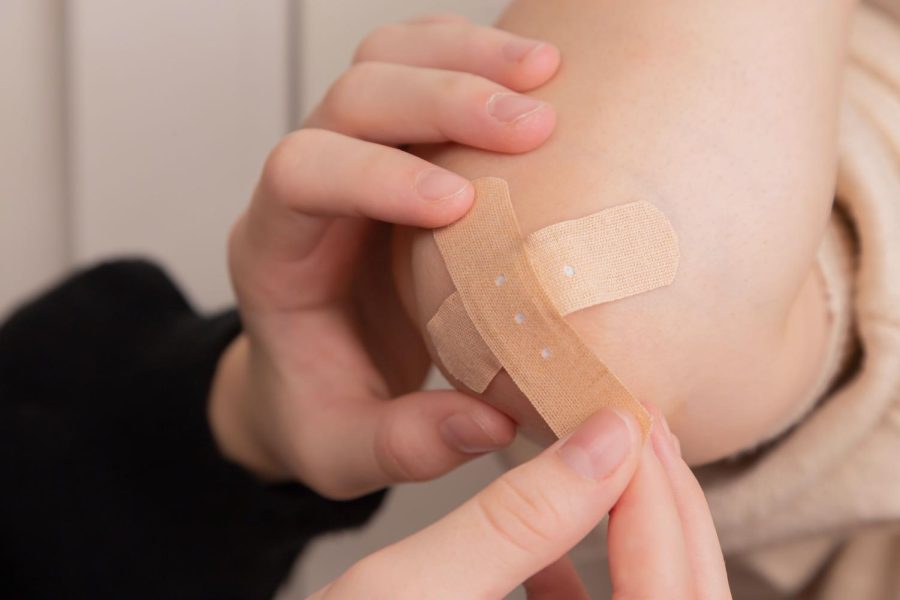How to Handle Bruises From A Fall
April 8, 2022
At a recent track meet, less than two seconds into the race, I saw my life flash before my eyes as I fell straight down in slow-motion. In an instant, I blinked to see the brick red, bumpy surface of the track, inches away from my face. Somehow I managed to tangle my legs with another runner right behind me, as we both came tumbling down. Bruised on both knees, my shoulder, and my arm, I realized I was reliving the brutal experience of falling from sports or running and the painful aftermath. If this sounds like a situation that you have encountered (I’m sure we all have), don’t fret, because this article contains some simple and easy ways to clean up and heal your bruises cleanly and effectively!
“During my cross country season this year, at League Finals, I slipped and fell in the middle of the race. I could feel the pain coming to my knees, but I kept going and pulled through. After my race, I immediately followed some of the methods that are in DRICE, and I made sure to clean my cut really well since I fell on dirt and sand. I highly recommend resting and icing afterward!” said Senior Ashley Lin.
The most effective method that I have found uses the acronym DRICE!
D-Disinfect
Immediately after receiving a bruise, it’s best to disinfect the area. Even if it’s bleeding, gently wash with warm or lukewarm water (and soap if you want!) to clean and sanitize the area. Especially if you are initially left with a cut, it’s important to remove the dirt and dust particles that might cause bacteria later on. Many of us use Neosporin, which in itself is also known as Polymyxin B or Bacitracin.
R-Rest
Especially if your fall or injury was energy-taxing, it’s important to get rest! Rest is one of the most important ways that your body heals, so getting enough sleep and rest is vital. In many cases, you might want to stop whatever caused the initial injury to prevent further injury. You might be tempted to massage or scratch around the area, but don’t! Most bruises form when capillaries (small blood vessels) near the skin’s surface are broken by the impact of a blow or injury. By massaging or messing around the area, you can further damage your smaller blood vessels or make the bruised area larger. Additionally, if after resting for a couple of days and your bruised area is swelling, make sure to seek medical care.
I-Ice
Many times athletes are seen icing their leg, which is used to prevent blood flow for a certain amount of time, then allow the blood to rush back to the place to increase blood flow. Handling bruises is no different. If you have access to ice or an ice pack, it’s best to ice the bruised area for anywhere from 10 to 20 minutes, in a wrapped towel or a not-so-cold ice pack. Icing your bruise can not only reduce the size of the bruise, but it can also allow the area to heal faster. If you’re inclined to, you could ice several (two to three) times a day, but you can also over ice it, so be careful.
C-Compress
This one might not be the handiest for everyone, but compressing your bruised area helps the body heal faster. Especially if the area is swelling, you might want to use an elastic bandage, which has similar effects to the ice. Make sure to wrap it around the area firmly, but not too tight.
E-Elevate
This last pointer is pretty easy to do! All it requires is for you to lift your leg or any area with a bruise higher than your heart. For example, if I were sitting on my bed, I would stack about two pillows on top of each other and put my calf on it to elevate my leg! Try to use gravity to your advantage so you’re not sitting or lying in an uncomfortable position for long periods. The science behind this is, if the bruise is below the horizontal level of your heart, the blood there pools more easily, easily making the bruise larger. However, if the bruise is above your heart, more blood is likely to flow back to your heart.
Lastly, hopefully, you don’t find yourself in this position anytime soon, but in the scenario that you are in the midst of a fall and have time to think back to this article, remember to lean forward into the fall and “fall like a sack of beans”. The last thing you want to do when falling is to try to go against gravity or try to force something that is not going to happen naturally. Protect areas of your body that are extremely vulnerable like your head and neck!
Photo courtesy of UNSPLASH.COM

